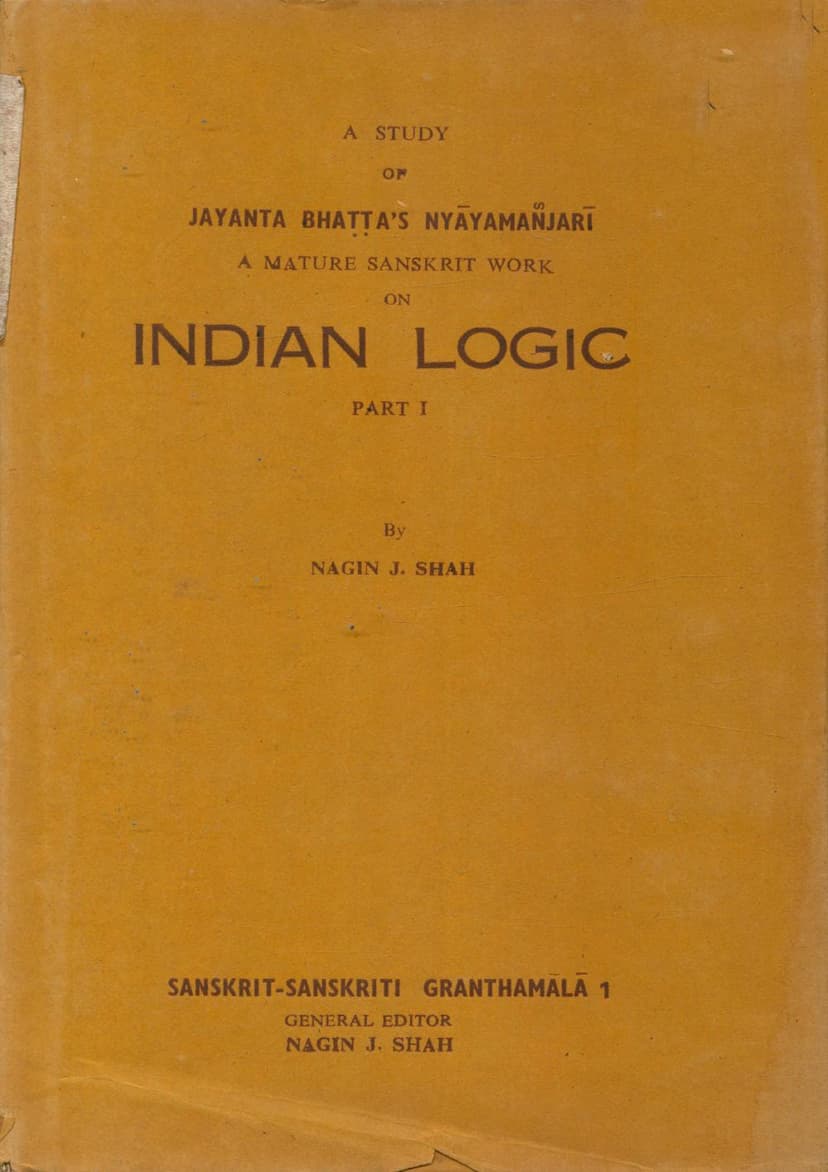Indian Logic Part 01
Added to library: September 1, 2025

Summary
This is a summary of the book "Indian Logic Part 01" by Nagin J. Shah, which is a study of Jayanta Bhatta's Nyayamañjari.
Overview:
The book is the first volume in the "Sanskrit-Sanskriti Granthamala" series and focuses on the first chapter of Jayanta Bhatta's Nyayamañjari, a significant work on Indian logic written in Sanskrit. Jayanta Bhatta, a Kashmiri scholar from the 9th century CE, was a prominent logician and philosopher who defended the Nyaya school's theories, particularly against Buddhist and Mimamsaka opponents. The study aims to provide scholars with a detailed analysis of this crucial part of Indian philosophical discourse, highlighting the intellectual contests of the era.
Jayanta Bhatta and Nyayamañjari:
- Author: Jayanta Bhatta (9th century CE), a Kashmiri pundit.
- Work Studied: Nyayamañjari, a commentary on the Nyayasutra but functioning as an independent work on Nyaya philosophy.
- Context: Written while Jayanta was in prison, the Nyayamañjari is praised for its mature discussion, lucid Sanskrit, and blend of prose and verse.
- Significance: It represents the "golden period" of Indian philosophy (7th-9th centuries CE) and showcases the triangular philosophical contest between the Nyaya, Mimamsa, and Buddhist schools. These schools primarily engaged with and criticized each other, contributing to the depth and sharpness of Indian philosophical thought.
Structure of the Study (Based on Chapter I of Nyayamañjari):
The book's first chapter of the Nyayamañjari is analyzed by Nagin J. Shah through four main points:
-
Defining Pramāṇa (Means of Valid Cognition):
- Jayanta Bhatta defines pramana not just as valid cognition itself, but as the "chief cause" or "instrument" of valid cognition.
- He engages with and criticizes definitions proposed by the Buddhists, Mimamsakas, and Sankhyas.
- A significant portion of this section details the Nyaya school's historical development in defining pramana, particularly the shift from "valid cognition" to "cause of valid cognition" and the debate on what constitutes the "chief cause" (karana). The author highlights Jayanta's departure from the traditional Nyaya view of a causal aggregate as the instrument, advocating for the aggregate itself as the chief cause.
- Jayanta's critique of the Buddhist and Mimamsaka views on pramana is explored, revealing their different ontological presuppositions regarding cognition.
-
The Buddhist Twofold Classification of Pramāṇa:
- Jayanta defends the Nyaya position of four pramanas (perception, inference, analogy, verbal testimony) against the Buddhist assertion of only two (perception and inference).
- The discussion delves into the Buddhist understanding of perception as devoid of any thought element (kalpana or vikalpa), a concept Jayanta finds problematic.
- Jayanta criticizes the Buddhist view that perception grasps particulars and inference grasps universals, and the idea that perception is solely sensory experience while thought is cognition.
- Key Buddhist arguments debated include:
- Pramāṇa being identical with pramāṇaphala (result of pramana).
- The exclusion of non-cognitive factors from pramana.
- The simultaneous origination of cognition and its object.
- The cognition taking on the "form" of its object.
- Jayanta also addresses the Buddhist concept of svabhāva-anumana (inference based on essential nature) and its relation to arthāpatti.
-
Arthāpatti as an Additional Pramāṇa (Mimamsa View):
- Jayanta critiques the Mimamsa school's (specifically Kumarila's) inclusion of arthāpatti (postulation or implication) as a separate pramana.
- The study details the Mimamsaka examples of arthāpatti, which involve cases where one piece of knowledge remains unaccounted for without positing another. These are categorized into four types based on positing "capacity," cases involving absence, and cases involving linguistic interpretation.
- Jayanta argues that arthāpatti is essentially a form of inference, challenging the Mimamsaka's attempts to distinguish it, particularly through the concept of "capacity" and the establishment of invariable concomitance through conceptual analysis rather than observation.
- The book examines Jayanta's refutation of arthāpatti, which involves analyzing its logical structure and ontological underpinnings, often highlighting the limitations in the Mimamsaka's reasoning.
-
Abhāva (Non-cognition/Absence) as a Pramāṇa (Mimamsa View):
- Jayanta addresses the Kumarilite Mimamsaka's contention that abhāva (absence or non-cognition) is an independent pramana.
- The core of the debate here is how "absence" is cognized. While Naiyayikas believe it's known through perception (as a quality of its locus), the Mimamsakas argue for a distinct pramana of abhāva because absence, lacking physical contact, cannot be perceived.
- Jayanta refutes this, arguing that absence is a valid object of perception and that the Mimamsaka's distinction is flawed. He analyzes cases of perceiving absence, contrasting them with inference.
- The study also covers Jayanta's critique of the Buddhist and Prabhakara positions on absence, particularly their denial of absence as an independent reality. Jayanta emphasizes the independent reality of "absence" within the Nyaya framework.
Key Themes and Contributions:
- Inter-school Polemics: The book vividly illustrates the intellectual battles and arguments among the major Indian philosophical schools.
- Epistemology (Pramana): A central focus is the definition and scope of valid means of knowledge, showcasing how different schools developed intricate logical systems.
- Ontological Differences: The differing views on the nature of reality (e.g., whether absence is real or not) underpin many of the logical disagreements discussed.
- Methodology: The study highlights the rigorous analytical methods employed in Indian logic, evident in Jayanta's detailed critiques and elaborations.
- Historical Context: The work situates Jayanta's philosophical contributions within the broader intellectual landscape of ancient India.
In essence, "Indian Logic Part 01" provides a scholarly exposition of a foundational text in Indian logic, offering insights into the sophisticated philosophical debates and the rigorous reasoning employed by its proponents. It demonstrates the depth and complexity of Indian epistemology and metaphysics.